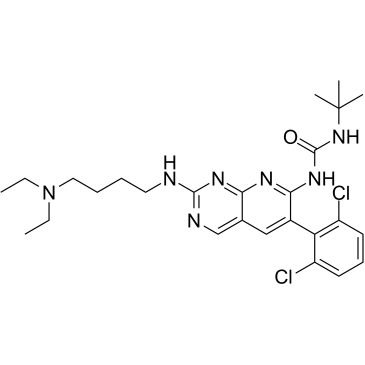| Cas No.: | 192705-80-9 |
| Chemical Name: | N-[6-(2,6-Dichlorophenyl)-2-[[4-(diethylamino)butyl]amino]pyrido[2,3-d]pyrimidin-7-yl]-N'-(1,1-dimethylethyl)urea |
| Synonyms: | PD-161570; PD 161570; PD161570. |
| SMILES: | O=C(NC(C)(C)C)NC1=NC2=NC(NCCCCN(CC)CC)=NC=C2C=C1C3=C(Cl)C=CC=C3Cl |
| Formula: | C26H35Cl2N7O |
| M.Wt: | 532.514 |
| Description: | PD-161570 is a potent and ATP-competitive human FGF-1 receptor inhibitor with an IC50 of 39.9 nM and a Ki of 42 nM. PD-161570 also inhibits the PDGFR, EGFR and c-Src tyrosine kinases with IC50 values of 310 nM, 240 nM, and 44 nM, respectively. PD-161570 inhibits PDGF-stimulated autophosphorylation and FGF-1 receptor phosphorylation with IC50s of 450 nM and 622 nM, respectively[1][2]. PD-161570 is also a bone morphogenetic proteins (BMPs) and TGF-β signaling inhibitor[3]. |
| Target: | FGFR1:39.9 nM (IC50) FGFR1:42 nM (Ki) FGFR1 autophosphorylation:622 nM (IC50) PDGFRβ:262 nM (IC50) PDGFR:310 nM (IC50) EGFR:240 nM (IC50) c-Src:44 nM (IC50) TGF-β Receptor |
| In Vitro: | PD-161570 (Compound 6c; 0.1-1 µM; 1-8 days; VSMCs) treatment inhibits PDGF-stimulated vascular smooth muscle cell proliferation in a dose dependent fashion with an IC50 of 0.3 µM at day 8[1]. PD-161570 suppresses constitutive phosphorylation of the FGF-1 receptor in both human ovarian carcinoma cells (A121(p)) and Sf9 insect cells overexpressing the human FGF-1 receptor and blocked the growth of A121(p) cells in culture[2]. PD-161570 can potent inhibit basic fibroblast growth factor (bFGF)-mediated angiogenesis[4]. Cell Proliferation Assay[1] Cell Line: Vascular smooth muscles cells (VSMCs) Concentration: 0.1 µM, 0.3 µM, 1 µM Incubation Time: 1 day, 3 days, 6 days, 8 days Result: Inhibited VSMC proliferation in a dose dependent fashion with an IC50 of 0.3 µM at day 8. |
| References: | [1]. Hamby JM, et al. Structure-activity relationships for a novel series of pyrido[2,3-d]pyrimidine tyrosine kinase inhibitors. J Med Chem. 1997 Jul 18;40(15):2296-303. [2]. Batley BL, et al. Inhibition of FGF-1 receptor tyrosine kinase activity by PD 161570, a new protein-tyrosine kinase inhibitor. Life Sci. 1998;62(2):143-50. [3]. Kyosuke Hino, et al. An mTOR Signaling Modulator Suppressed Heterotopic Ossification of Fibrodysplasia Ossificans Progressiva. Stem Cell Reports. 2018 Nov 13;11(5):1106-1119. [4]. Wolfe A, et al. Pharmacologic characterization of a kinetic in vitro human co-culture angiogenesis model using clinically relevant compounds. J Biomol Screen. 2013 Dec;18(10):1234-45. |

 To enhance service speed and avoid tariff delays, we've opened a US warehouse. All US orders ship directly from our US facility.
To enhance service speed and avoid tariff delays, we've opened a US warehouse. All US orders ship directly from our US facility.




















